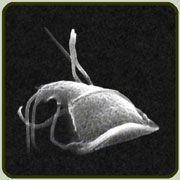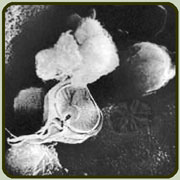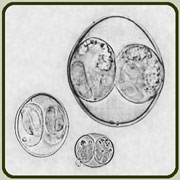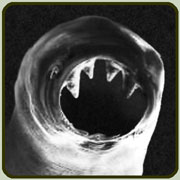Internal
Parasites
Internal parasites that affect chinchillas
are Giardia, Coccidia,
Cryptosporidium and Tapeworms,
Hookworms and Nematodes such as Roundworms
and Pinworms. These parasites are all common in the
GI tract, and in some fashion all of them decrease the absorption of nutrients
in your animal. In the adult animal this is not as much of a problem as
it is in the young, growing animal; as the young animal might not be able
to grow and develop in a completely healthy manner leaving it open to
other problems later on. We postulate that these problems might be some
of the reasons that our animals come up with tooth root growth, sheer
mouth in molars [commonly and erroneously called malocclusion] and maybe
even easily broken bones later on in life.
Giardia
Giardia is a flagellate protozoan, that is it has a whip like tail. It
also has a sucker like mouth and attaches itself to the surface of intestinal
mucosa. The method of contamination is fecal-oral; this is when dirty
paws or feces gets into feed, and other chins eat the food. Humans can
catch the giardia by using unwashed hands to handle food, and pass it
onto other animals by handling their food with unwashed hands. The eggs
[oocysts] travel from the mouth, through the stomach and into the small
intestine and there lodge and multiply.
Chinchillas normally harbor giardia species in low numbers [Donnelly etal] which commonly causes no problems for the chinchilla. But, under stress, in the presence of a dirty environment, contaminated water supplies, or at times when the immune system is lowered in other illnesses or trauma the Giardia can then cause disease. [If you don't think your water supply can possibly be contaminated, remember that the levels that are safe for humans are higher than levels of the same organism that are safe for something as small as a chinchilla. Know too that the whole Sierra Nevada water system is contaminated with Giardia, and the Rocky Mountain water system is fast becoming so.]



The symptoms tend to be anything from increased appetite, to decreased activity, diarrhea [or constipation] and even collapse. The diarrhea tends to be large wet stools that shine with mucous, are very squashy and tend to be smeared on the house, perches, and other flat surfaces of the chinchilla cage. Diagnosis is best done on a fresh fecal smear-- take your sick chinchilla to a vet, let him/her get a piece of feces dropped within the past 2 minutes in the office, place it onto a slide and squash it, and put a couple drops normal saline onto the slide. The slide should show the giardia easily. Treatment is usually recommended to be metronidazol [flagyl] but we have found better success with albendazole or fenbendazole. Care of the animal consists of fluids to replace fluids lost in the diarrhea [see diarrhea], high energy foods [see food supplements] and cleaning the cage and environment of the chinchilla with good disinfectants such as 20% bleach, dettrol, lysol etc.
Coccidiosis
Coccidiosis are cystic in nature, in that they form walled cases around
the protozoan, this makes them harder to kill. They also shed the egg
and are transmitted by the fecal - oral route. In this case the cyst then
invades the wall of the intestine of an imunosupresed host, getting into
the lymph system which makes it harder to eradicate and there divides
asexually. This too causes weight loss, increased appetite, severe diarrhea
accompanied by dehydration [see diarrhea] and sometimes even some hidden
bleeding. Again the diagnosis is made with a fresh sample of feces and
seen as a wet mount under the microscope. The vet should see unsporoated
oocysts being shed in the feces. There are other tests that can be run
if the vet has a high suspicion, but cannot see the egg under the microscope.
In this case it is very important to have a very very new stool sample
for the vet to see in order for the eggs/cysts to be seen. Again, treatment
is by oral medications, usually sulfonamides, and supportive care for
the animal with high nutrition foods, and fluids. Sterilizing the cage
and disposing of wooden houses, and pieces of carpet is absolutely necessary.
Coccidiosis tends to be a disease problem in areas of poor sanitation, so animals should be housed to prevent contamination of food and water by contaminated feces. If infected, food and water dishes should be disinfected by steam cleaning or immersion in boiling water, 5% ammonia solutions can also help disinfect the cage and dishes. Insect control is also essential as flies and cockroaches may serve as insect vectors of the oocysts.

Worms
Usually, if your animal has worms, you should be able to see them. However,
if you suspect them, have the vet take a fecal sample for examination.
In these particular cases, the worming medicines albendozole/fenbendozole
work here too.

Cryptosporidia
Cryptosporidiosis is a member of the coccidia group, called Eimeria. It
also inhabits the epithelium of the digestive system, and also causes
lack of absorption, diarrhea and weight loss. The cryptosporidia is more
of a parasite in that it causes lesions of the lining of the intestinal
tract and can in some animals cause observable blood in the stools and
in larger animals has been known to cause hemorrhage. This parasite is
more infectious in that the eggs are immediately infectious when shed
and will invade the border of the intestine and immediately multiply causing
many small lesions or injuries. Again, the animal needs to be somewhat
imunosupresed, e.g. under stress or ill from another problem before it
can take hold, but it takes less to cause problems. [Cryptosporidia has
become more common in municipal water supplies, and one study published
in the Annals of Internal Medicine has found that all portions of the
population are susceptible, and that bottled water does seem to give some
protection against this organism.]
Again, crowding, and unsanitary conditions increase the risk to the animal. In this case, when the vet examines the fecal sample of your animal, the vet should kill the cyst in formalin before checking under the microscope, as this bug is more infective than other parasites. It can also infect you and your vet. Again, a fresh sample of stool examined under the microscope can give the vet a good idea of contamination. Other tests can be run, but this will give the veterinarian a good idea of what he is working with. This organism is harder to eradicate than the others, and most antibiotics used are used mainly to combat secondary infections. Your animal will probably be in severe dehydration, and parenteral fluids need to be given by the vet under those circumstances.
Care of your animal again consist of supportive care [see diarrhea and food supplements]. The cage, all cage materials, anything the animal has dropped feces onto, and its environment must be sterilized with a very strong disinfectant, bleach does not seem to kill this organism. All dishes should be boiled for at least 20 minutes or run through your dishwasher on sanitary cycle. Anything that is porous [carpeting, wooden shelves or houses, perches etc.] should be thrown away tied in plastic bags so not to contaminate the landfill.
If you feel your water is the culprit, you need to filter water through a very small ceramic filter, as most regular water filters are not small enough to catch any of these organisms. Boiling water for 20 minutes will also kill these organisms. The authors use either filtered water or purified bottled water for their animals.